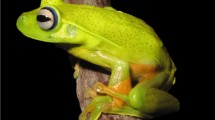Abstract
Japanese fireflies of the subfamily Luciolinae are biochemically analyzed using 13 allozymes, and the phylogenetic relationships obtained from this analysis are compared with their flash communication systems. As a result, the Japanese Luciolinae can be divided into three groups.Hotaria parvula andH. tsushimana together withLuciola yayeyamana andL. kuroiwae from the first group, and they use the same communication system.L. lateralis, Curtos okinawana, andC. costipennis make up the second group, and their communication systems are also the same.L. cruciata makes up the last one, and its communication system is different from the other fireflies of Luciolinae. Therefore, their taxonomical arrangement and communication systems are not congruent. However, the genetic similarity deduced by allozymic analysis of the members of the Japanese Luciolinae is highly consistent with their flash communication systems.
Similar content being viewed by others
References
Ballantyne, L. A. (1968). Revisional studies of Australian and Indomalayan Luciolini (Coleoptera: Lampyridae: Luciolinae).Pap. Dept. Ent. Univ. Qd. 2150.
Barber, H. S. (1951). North American fireflies of the genusPhoturis.Smithsonian Misc. Coll. 1171.
Beauchamp, C., and Fridovich, I. (1971). Superoxide dismutase: Improved assays and an assay applicable to acrylamide gels.Anal. Biochem. 44276.
Eanes, W. F., and Koehn, R. K. (1978). An analysis of genetic structure in the Monarch butterfly,Danaus plexippus L.Evolution 32784.
Felsenstein, J. (1991).PHYLIP Phylogeny Inference Package, Version 3.4 University of Washington, Seattle.
Ferguson, A. (1980).Biochemical Systematics and Evolution, Blackie.
Harvey, E. N. (1957). A history of luminescence.Am. Phil. Soc. Philadelphia 44669.
Lloyd, J. E. (1966). Studies on the flash communication system inPhotinus fireflies.Misc. Pub. Mus. Zool. Univ. Mich. 1301.
Lloyd, J. E. (1971). Bioluminescent communication in insects.Annu. Rev. Entomol. 1697.
Lloyd, J. E. (1972). Mating behavior of a New GuineaLuciola firefly: A new communicative protocol (Coleoptera:Lampyridae).Coleopt. Bull. 26155.
Lloyd, J. E. (1973). Model for mating protocol of synchronous flashing fireflies.Nature 245268.
Lloyd, J. E. (1983). Bioluminescence and communication in insect.Annu. Rev. Entomol. 28131.
McDermott, F. A. (1910). A note on the light-emission of some American Lampyridae.Can. Entomol. 42357.
McDermott, F. A. (1911). Some further observations on the light-emission of American Lampyridae: Adaptation in the Photinini.Can. Entomol. 43399.
McDermott, F. A. (1912). Observation on the light-emission of American Lampyrida.Can. Entomol. 44309.
McDermott, F. A. (1966).Coleopterorum Catalogus, Suppl. 9. Lampyridae Steel, W. O. (ed), W. Junk, s-Gravenhage.
Motschulsky, V. (1845). La collection de coleopteres Russes.Bull. Soc. Nat. Moscou 1836.
Murphy, R. W., Sites, J. W., Buth, D. G., and Haufler, C. H. (1990). Protein I: Isozyme electrophoresis. In Hill, D. M., and Moritz, C. (eds.),Molecular Systematics Sinauer, Sunderland, MA, p. 45.
Nei, M. (1972). Genetic distance between populations.Am. Nat. 106283.
Nei, M. (1975).Molecular Population Genetics and Evolution North-Holland, Amsterdam.
Nei, M. (1987).Molecular Evolutionary Genetics Columbia University Press, New York.
Olivier, E. (1907).Genera Insectorum, 53. Fasc. Coleoptera, Fam. Lampyridae Wytsman, M. P. (ed), Saint-Alphonse, Bruxelles.
Ohba, N. (1983a). Studies on the communication system of Japanese fireflies.Sci. Rep. Yokosuka City Mus. 301.
Ohba, N. (1983b). Flash communication inLuciola kuroiwae (Coleoptera: Lampyridae).Sci. Rep. Yokosuka City Mus. 311.
Ohba, N. (1985). Flash communication inHotaria tsushimana (Coleoptera: Lampyridae).Sci. Rep. Yokosuka City Mus. 3313.
Ohba, N., and Goto, Y. (1989). Morphology and behavior ofLuciola yayeyamana (Coleoptera: Lampyridae).Sci. Rep. Yokosuka City Mus. 371 (In Japanese with English abstract).
Suzuki, H., Sato, Y., Fujiyama, S., and Ohba, N. (1993). Genetic differentiation between ecological two types of the Japanese firefly,Hotaria parvula: An electrophoretic analysis of allozymes.Zool. Sci. 10697.
Yuasa, H. (1937). Description of a new genus of the family Lampyridae (Coleoptera).Kontyû 11107.
Author information
Authors and Affiliations
Rights and permissions
About this article
Cite this article
Suzuki, H., Sato, Y., Fujiyama, S. et al. Biochemical systematics of Japanese fireflies of the subfamily Luciolinae and their flash communication systems. Biochem Genet 34, 191–200 (1996). https://doi.org/10.1007/BF02407019
Received:
Revised:
Issue Date:
DOI: https://doi.org/10.1007/BF02407019




